IISc develops enhanced data encryption, security device
The process and the model was detailed by the team from IISc’s Electrical Communication Engineering department in a paper published in the journal ACS Nano, according to a statement by the institution.
Researchers at the Indian Institute of Science (IISc) on Friday said they have developed a new true random number generator (TRNG) with a “record-breaking” performance parameter.

Random numbers are a core component of the internet, computing and any application that involves data security and integrity. The numbers, to put it simplistically, create a cryptographic lock – the less predictable (more random) these numbers are, the more secure the encryption becomes.
The process and the model was detailed by the team from IISc’s Electrical Communication Engineering (ECE) department in a paper published in the journal ACS Nano, according to a statement by the institution.
“Almost everything we do on the internet is encrypted for security. The strength of this encryption depends on the quality of random number generation,” said Nithin Abraham, a PhD student at ECE, said in a statement.
Using computers to generate random numbers is inherently difficult since computing requires a set of instructions for an output and hence, the result is not truly random. Researchers have attempted variety of ways to create TRNGs, mostly by tapping into atmospheric or thermal patterns that are beyond human control.
In this case, the IISc team built a TRNG by relying on the random motion of electrons. Atoms and molecules are in a constant state of random motion – detecting the electrons they are made up of can capture this randomness. The IISc team created an artificial electron trap that generates a current every time an electron is trapped and this fluctuation leads to patterns that can then be used to generate numbers.
“You cannot predict exactly at what time the electron is going to enter the trap. So, there is an inherent randomness that is embedded in this process,” explained Kausik Majumdar, associate professor at ECE, who was involved in the project.
The IISc statement said that till now, most “cryptographic keys are typically generated in computers using pseudorandom number generators (PRNGs), which rely on mathematical formulae or pre-programmed tables to produce numbers that appear random but are not.
“In contrast, a TRNG extracts random numbers from inherently random physical processes, making it more secure,” according to the statement.
The performance of the device on the standard tests for cryptographic applications designed by the US National Institute of Standards and Technology (NIST) exceeded expectations, Majumdar said. “When the idea first struck me, I knew it would be a good random number generator, but I didn’t expect it to have a record-high min-entropy,” he says.
Min-entropy is a parameter used to measure the performance of TRNGs. Its value ranges from 0 (completely predictable) to 1 (completely random). The device from Majumdar’s lab showed a record-high min-entropy of 0.98, a significant improvement over previously reported value, which were around 0.89.
“Ours is by far the highest reported min-entropy among TRNGs,” said Abraham.
“Since our device is purely electronic, millions of such devices can be created on a single chip,” added Majumdar. He and his group plan to improve the device by making it faster and developing a new fabrication process that would enable the mass production of these chips.






